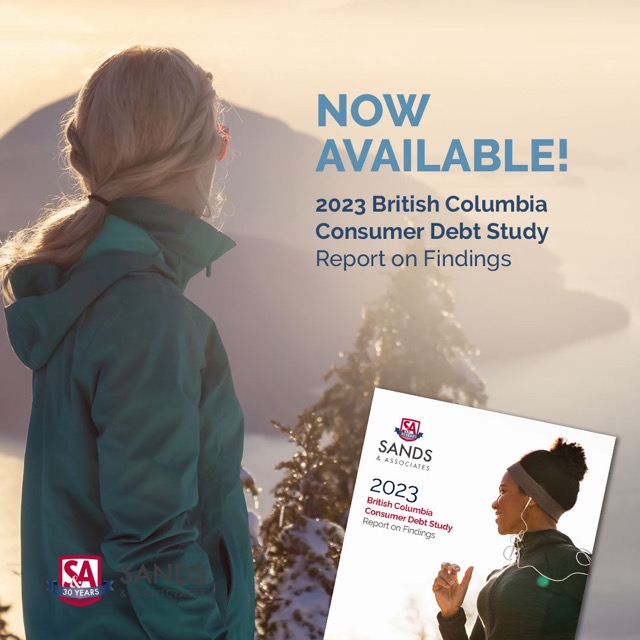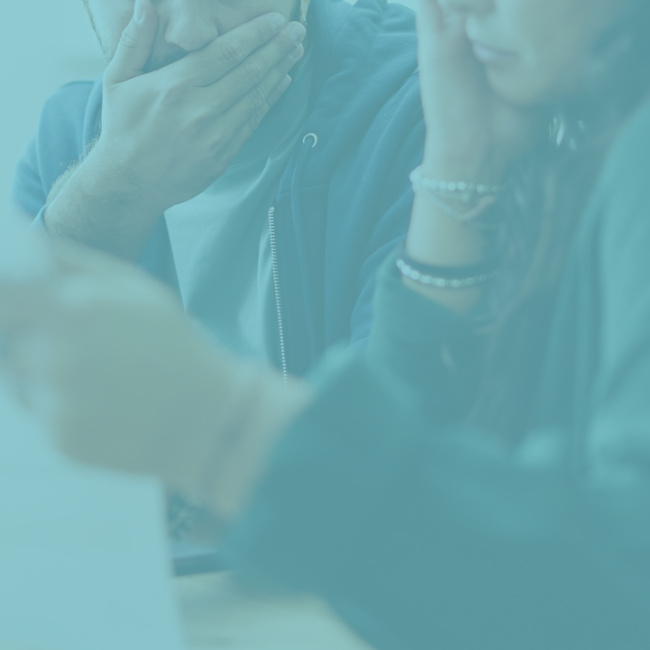The latest BC Consumer Debt Study shows that BC’s costs of living have become a key cause of debt problems, and challenges dealing with debt are taking a significant toll on the personal wellbeing of thousands of British Columbians.
Having polled over 1,700 participants who recently restructured their debts using a legal debt solution, the 2023 BC Consumer Debt Study offers a unique view into consumer debt issues in the province. Blair Mantin, President of Sands & Associates, the firm of Licensed Insolvency Trustees who undertook the study, joined CTV News to discuss the study’s findings.
Watch the clips here and learn more below:
Recent BC Consumer Debt Problems – by the Numbers
- The 2023 BC Consumer Debt Study’s largest proportion of participants (36%) said they had $25,000-$49,999 of debt (excluding vehicle loans/mortgages) when they started a formal debt relief process.
- Almost 3 in 5 people (58%) said credit card debt was the main type of debt they had, nearly five times higher than the next debt type.
- Close to 1 in 8 individuals (12%) claimed payday or instalment loans was their main type of debt, and tax debt (personal income tax, GST, etc.) took the third spot at 11%.
Credit cards and payday loans can be considered interest-heavy credit, and consumers can easily develop a borrow-repay-borrow cycle that is often impossible to break with interest rapidly accumulating.
Dos and Don’ts for Credit Cards and Managing Your Credit Card Debt – Read More
What Are Some Common Causes of Personal Debt Problems?
The common causes of debt revealed in the 2023 BC Consumer Debt Study expose the vulnerability of many consumers when it comes to their ability to financially weather personal and economic challenges. Five of the top six common causes of debt as reported by insolvent consumers relate to triggering events or circumstances that are likely beyond an individual’s clear control:
- Just over a quarter of BC consumers polled (27%) said their debt was caused by overextended credit due to general financial mismanagement.
- Closely following, the second-most reported cause of debt for 1 in 4 consumers (25%) was using credit for essential costs of living income could not cover.
- Following these, the remaining top six causes of individuals’ debt were attributed to: Illness, injury, or health-related problems (11%); Marital or relationship breakdown (7%); Job related issue (5%) and Pandemic-related job loss or reduction in work hours (5%).
95% of individuals participating in the 2023 BC Consumer Debt Study said their household has been impacted by recent inflation increases, with the largest proportion (88%) noting inflation has their household now spending more on necessities such as food and gas.
- Half (50%) also say their household is no longer able to accumulate as much savings, leaving consumers further exposed to difficulties in meeting unanticipated financial needs.
There was a bright spot in the findings; however, with over 4 in 5 people (87%) saying their insolvency filing (making a Consumer Proposal or declaring Personal Bankruptcy) has helped them manage day-to-day finances despite noticeable rising costs.
What Happens When You Can’t Pay Your Debt? Learn More
Steep Costs of Unmanageable Debt – Coping with a Debt Problem
Individuals participating in the 2023 BC Consumer Debt Study reported a range of ‘symptoms’ brought on by their unmanageable debt, including:
- 4 in 5 people (83%) said they had a constant worry about debt.
- Nearly 4 in 5 people (79%) said their mental health suffered by being in debt, and 3 in 5 (61%) said their self-esteem suffered because of being in debt. Almost half of respondents (49%) said debt caused their physical health to suffer.
- Over three-quarters of individuals surveyed (77%) said they experienced anxiety from the stress of debt; also 66% feelings of helplessness or hopelessness, and 61% depression.
- Almost 1 in 6 people (16%) said they experienced suicidal ideation because of their debt-stress.
Debt Warning Signs and Delays Seeking Debt Help
Over 7 in 10 people polled (71%) said overwhelming stress was how they knew their debts were becoming a problem – and despite this, more than 96% of survey respondents did not seek professional help right away.
- Most respondents (64%) said they waited to seek professional debt help because I wanted to manage my debt on my own.
- Further top reasons individuals said they waited to seek professional support were: I felt ashamed I couldn’t handle the debts I had incurred (56%) and I was embarrassed to ask for help (51%).
Other top-identified signs of a debt problem reported by consumers were more transactional:
- Only making minimum payments (60%).
- Seeing debt balances remain almost the same every month, despite making payments (55%).
A lack of visibility around legal debt help resources was also a significant barrier that contributed to individuals postponing seeking professional support, with a third of survey respondents (34%) saying I thought there was no solution to my situation; more than 1 in 4 (27%) I didn’t know where to seek help and 17% I had misinformation about how the Consumer Proposal and/or Bankruptcy process worked.
Debt Forgiveness with Personal Bankruptcy: Step-by-Step
How Did People Attempt to Solve Their Debt Problems?
Despite the significant personal impacts of their debt issues, fewer than 4% of people polled said they sought help right away from a debt help professional, and, in this time, individuals attempted a variety of different tactics to solve their debt problems.
- Many people turned to more borrowing to try to manage their debt, with over a third of survey participants (36%) saying they applied to extend credit limits on existing debts and 34% who borrowed from family or friends to make debt payments.
- More than 1 in 4 individuals (26%) applied for consolidation financing; 25% used payday or instalment loans, and 4% asked family or friends to co-sign a consolidation loan.
Participants in the 2023 BC Consumer Debt Study overwhelmingly used a Consumer Proposal to legally consolidate and cut their debt (81% of study respondents), and over 90% of all individuals surveyed said they were satisfied with their decision to eliminate their debts with an insolvency process.
More people than ever before are choosing to use a Consumer Proposal to consolidate and cut their debt, rather than file for bankruptcy.
Learn More About Consumer Proposals
Getting Debt Help – Where Consumers Can Get Qualified Support
Blair Mantin, President of Sands & Associates, says that, unfortunately, it can be frustrating and discouraging for consumers who attempt to self-manage their debt for too long, and that overwhelmed consumers are highly vulnerable to inferior, unregulated, and even illegal services sold by debt settlement agents or debt advisors.
- Consumers are encouraged to get impartial and accurate advice from a Licensed Insolvency Trustee at the onset of a debt problem.
- Licensed Insolvency Trustees are Canada’s only established debt help professionals and are fully regulated, qualified, and endorsed to serve Canadians with a range of debt management services and advice.
- You do not need to be dealing with an extreme situation to seek support from a Licensed Insolvency Trustee, and consumers can get free, confidential advice at any point.
- Connect directly with a local Licensed Insolvency Trustee to better understand your situation, get accurate information, and explore all possible options in a free, confidential debt consultation.
- No referral, payments, or third-party agents are necessary.
Non-judgmental debt support for individuals and a full suite of debt help services is available to you. Connect with a caring local debt expert by phone, video, or in-person – book your free, confidential consultation today.






